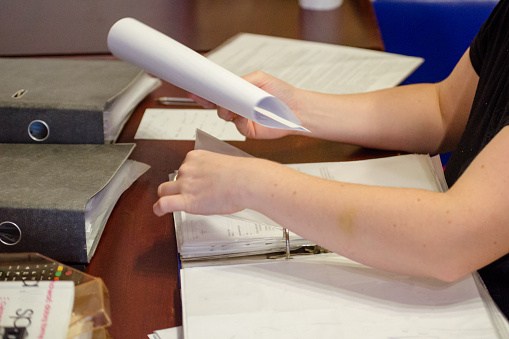- Our School
- Our Advantage
- Admission
- Elementary•Middle School
- High School
- Summer
- Giving
- Parent Resources
- For Educators
- Alumni
« Back
How to Organize Your Child's IEP Binder
March 19th, 2018

This resource originally appeared on Understood.org. Reprinted courtesy of Understood.org ©2018. Understood, LLC. All rights reserved.
This is one of four posts about navigating the IEP process. Read the other articles: Questions to Ask Before and During Your Child's IEP Meeting, 5 Important Things to Do After the IEP Meeting, and 6 Tips to Make Sure Your Child's IEP Is Implemented Properly.
Making an IEP binder is a great way to keep information organized and at the ready when you need it.
Making an IEP binder is a great way to keep information organized and at the ready when you need it. An IEP binder can help you prepare for IEP meetings and stay up to date on your child’s progress. This powerful tool can also help you communicate and collaborate with teachers and your child’s IEP team. Here’s what you need to get started:
- A three-ring binder
- Six tabbed section dividers
- A three-hole punch
Organizing an IEP binder with your child’s evaluation reports, IEP, report cards and other paperwork may sound like a lot of work. But this guide walks you through what to gather and where to put it.
Start With the IEP Binder Checklist
Print this IEP binder checklist and put it in the very front of your binder. The checklist has details about what you can put in each of the tabbed sections in your IEP binder. The checklist has another very important purpose: You can update it as you add new paperwork. As your binder grows, this checklist will help you see what you’ve updated and when you updated it.
Tab 1: Communication
Print and fill out a school contact sheet and put it in the front of this section. The contact sheet will help you quickly find and reach out to key people with questions or concerns. Next is the parent-school communication log. Print one out and use it to help you keep track of meetings, phone calls, emails and other important interactions you have with your child’s teacher and school. As you fill out each entry, be sure to note what was discussed and what was decided. The rest of this section is for letters and important emails. Put the newest ones on top, behind the communication log. Why keep printed copies of emails? Having a paper version in your binder means you’ll have it on hand for meetings, so you can easily find and reference what was said. As you file letters and emails in this section, remember to include a brief summary of each one in the communication log.
Tab 2: Evaluations
Start this section with the request or referral for evaluation. After that put in your consent to evaluate. Keeping these two documents together can help you see if the school completes the evaluation in a timely manner. Next comes the school-based evaluation report. (It’s handy to have this in the same section as your request for evaluation, so you can match up each request with the evaluation results.) If your child has had a private evaluation, include that here too. Down the road, your child might have another school-based evaluation. If so, file it as a trio that includes the new request or referral and the new consent form. Put this new set of documents on top of the previous set. Also, in this section, you may want to consider flagging key information with paper clips or sticky notes. Come up with a system that can help you quickly find what you want to discuss with the IEP team.
Tab 3: IEP
It’s a good idea to start this section of your IEP binder with a copy of your rights and procedural safeguards the school gives you. That’s because whenever you go to an IEP meeting, the IEP team will offer another copy. It’s important information. But if you show the school you already have it, you can avoid taking home another big stack of paper! In this section, file your child’s IEP and the prior written notice for each meeting related to the IEP. Many schools attach meeting notes to the prior written notice form. Keep those notes here as well as your own notes from the IEP meeting. The IEP needs to be updated annually. But you may have more than one meeting a year. And if changes are made to the IEP, put the newest plan and prior written notice on top, behind the procedural safeguards.
Tab 4: Report Cards/Progress Notes
The federal law, the Individuals with Disabilities in Education Act (IDEA), says you have to be updated on your child’s progress toward his IEP goals at least as frequently as you get progress reports on his general education. Keep these progress notes and report cards in this section. And if you want to keep track of your child’s progress on your own, print and use this IEP goal tracker. It can help you monitor your child’s progress toward each annual goal in the IEP.
Tab 5: Sample Work
Use this section to file samples of your child’s homework or classwork that show signs of progress or concern. (This is especially important for work that’s noted on the goal-tracker form.) It’s a good idea to file samples at least monthly. And just like in the other sections of your IEP binder, put the newest stuff on top to help you find the most up-to-date information.
Tab 6: Behavior
In this section, file a copy of the school’s code of conduct. If your child is in middle or high school, his teachers may have also sent home class-specific behavior plans and rules. Keep copies of these here, too. Next comes your child’s behavior intervention plan or behavior contract, if he has one. This is also the place to file disciplinary notices, if your child receives any. Why keep these in your IEP binder? Because your child has additional rights and protection if the behavior he’s disciplined for could be related to his disability.
Consider Including a Supply Pouch
Since your IEP binder will come to IEP meetings with you, you may want to add a zippered supply pouch. Stocking it with some pens and an extra set of sticky notes means you’ll have one less thing to worry about during your IEP meeting. And last but not least, remember that organizing your child’s IEP binder may take some time at first. But once the initial steps are done, it’s easy to maintain! When it comes to overseeing your child’s IEP, the less time you have to spend hunting for paperwork, the more time you can focus on questions to ask before and during the IEP meeting.
About the Author

Amanda Morin is a parent advocate, a former teacher and the author of The Everything Parent’s Guide to Special Education.
Posted in the category Learning Disabilities.






















